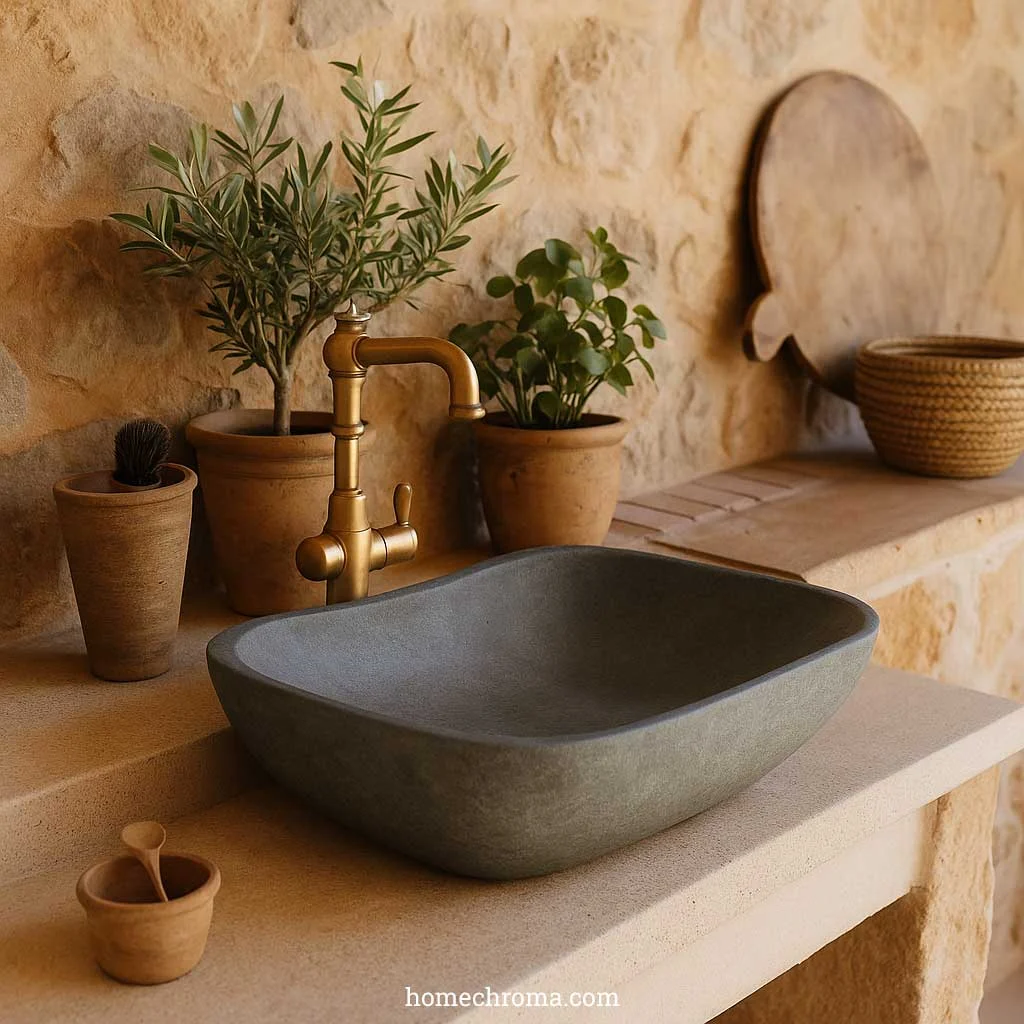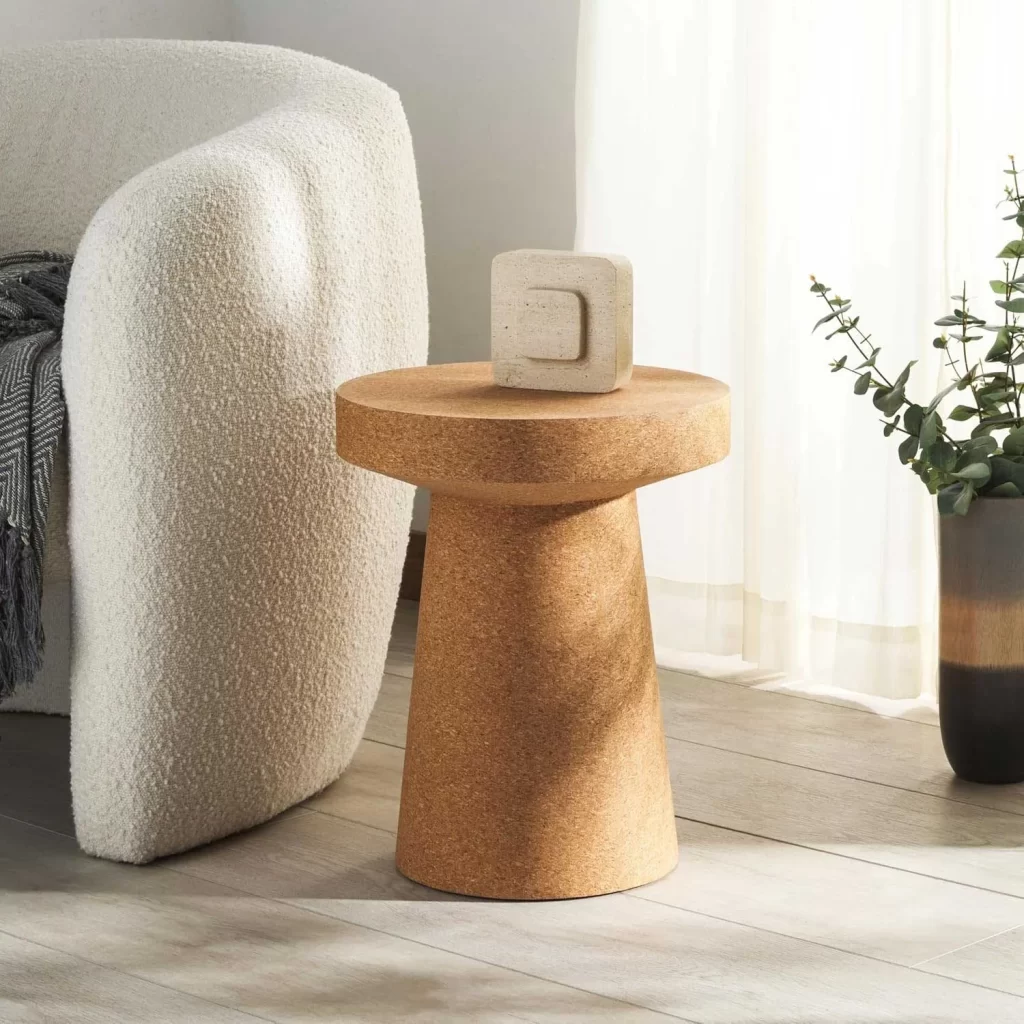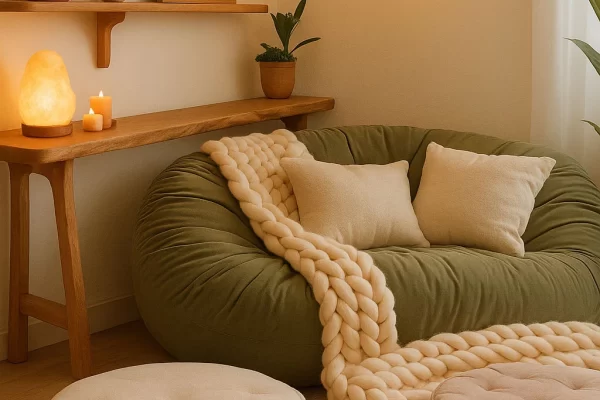
In biophilic design, which connects people with nature in built environments, the durability of natural materials is crucial. This comparison examines how various natural materials stand the test of time, helping you make informed choices for long-lasting biophilic installations.
What Makes Natural Materials Essential in Biophilic Design?
Natural materials form the backbone of biophilic design, creating authentic connections to nature within built spaces. These materials bring textures, patterns, and colors from the natural world into our indoor and outdoor environments.
When selecting natural materials for biophilic applications, durability becomes a critical factor:
- It maintains the intended design aesthetic over time
- It minimizes replacement needs and associated costs
- It reduces resource consumption and waste
- It aligns with sustainability principles
Comprehensive Durability Comparison of Natural Materials

Wood
Walnut wood three legged stool [link]
Interior Lifespan: Decades to centuries
- Hardwoods like oak, teak, and mahogany can last centuries with proper care
- Softwoods typically last 50+ years in protected environments
- Engineered wood such as CLT offers enhanced durability and water resistance
Exterior Lifespan: 15-40+ years
- Naturally durable hardwoods can last 40+ years without treatment
- Most softwoods require preservative treatment for exterior use, lasting 10-30 years
- Thermally treated wood shows improved weather resistance
Durability Factors:
- Moisture (primary cause of decay)
- UV radiation (causes fading and weakening)
- Prolonged dry conditions (can cause cracking)
- Pests like termites and beetles
Enhancement Methods:
- Thermal treatment increases resistance to water damage and pests
- Pressure treatment protects against termites and fungal decay
- Sealing creates barriers against moisture and UV radiation
Stone
Oval River Stone Washbasin [link]
Interior Lifespan: Centuries
- Harder varieties like granite and quartzite can last for centuries
- Softer stones (marble, limestone) typically last 20-50 years
- Natural stone veneer can last 50+ years with minimal maintenance
Exterior Lifespan: Centuries (for durable types)
- Granite and slate can last centuries for outdoor paving and walls
- Limestone is more susceptible to weathering and erosion
- Natural stone veneer maintains weather resistance for 50+ years
Durability Factors:
- Moisture affects porous stones like limestone
- Weathering and erosion impact softer stones
- High traffic causes surface degradation
- Acids and chemicals can stain or etch certain types
- Installation quality affects water infiltration
Enhancement Methods:
- Sealing protects porous stones from stains and moisture
- Choosing appropriate finishes improves scratch resistance
- Regular cleaning with suitable products maintains appearance
Bamboo
Pipishell Bamboo Stackable End Tables [link]
Interior Lifespan: 25-50+ years
- Treated bamboo can last over 50 years indoors
- Bamboo decking properly maintained can last 25+ years
- Natural wicker furniture made from bamboo lasts 5-15 years indoors
Exterior Lifespan: 3-30+ years
- Untreated bamboo directly exposed to elements lasts 3-4 years
- Properly treated bamboo can last 20-30+ years
- In dry climates, natural bamboo may last 10-15 years outdoors
Durability Factors:
- High susceptibility to rot and mold when exposed to moisture
- UV radiation degrades the material over time
- Natural starch content attracts insects
- Harvesting timing affects starch content and pest susceptibility
- Without treatment, bamboo deteriorates within months
Enhancement Methods:
- Chemical treatment with boron and boric acid repels insects
- Thermal treatment improves pest and moisture resistance
- Water leaching removes water-soluble substances that attract pests
- Smoking and heating reduce pest infestation
- Saltwater immersion helps fibers release sugary sap
Cork
Interior Lifespan: 50+ years
- Highly resilient to pressure
- Resistant to moisture
- Cork flooring can last 50+ years
Exterior Lifespan: 50+ years
- Cork external render or wall coating lasts 50+ years
- Natural water resistance allows it to withstand elements
Durability Factors:
- Excessive sunlight causes fading
- Susceptible to scratches, particularly from pets
Enhancement Methods:
- Sealing and finishing protect against wear in high-traffic areas
- UV protective coatings mitigate fading
Natural Fibers (Cotton, Hemp, Linen, Wool)
Interior Lifespan: Years to decades
- Hemp is extremely durable, becoming softer with use
- Linen offers strong durability, lasting many years with proper care
- Wool shows resilience, making it suitable for upholstery and carpets
- Cotton becomes stronger when wet but has moderate durability
Exterior Lifespan: Limited
- Not recommended for prolonged exterior use
- Hemp might work for specific outdoor applications with proper treatment
Durability Factors:
- Moisture leads to mildew, mold, and fiber weakening
- UV exposure causes fading and degradation
- Wear and tear varies by fiber type and application
- Pests like moths can damage certain fibers
- Improper washing and care reduces lifespan
Enhancement Methods:
- Chemical treatments reduce hydrophilic nature
- Blending with more durable fibers improves strength
- Durable and ethically sourced dyes maintain quality
- Protective finishes resist stains and wear
Clay, Terracotta, and Brick
Ceramic Palo Santo Holder Burner [link]
Interior Lifespan: Decades
- Durable for flooring, tiles, and decorative accents
- Terracotta flooring maintains beauty and functionality for many years
Exterior Lifespan: 50-150+ years
- Terracotta brick walls last 50+ years with proper maintenance
- Clay bricks typically last 150+ years
- Terracotta roof tiles can last a century or more
Durability Factors:
- Raw material quality affects overall strength
- Manufacturing process, particularly firing temperature and duration
- Exposure to severe weather conditions
- Installation techniques impact water drainage
- Routine maintenance preserves integrity
Enhancement Methods:
- Proper sealing protects from stains and moisture
- Preventive measures ensure proper drainage
- Protective sealants provide defense against moisture
- Regular cleaning prevents buildup of damaging substances
Wicker and Rattan
Interior Lifespan: 5-20 years
- Natural wicker furniture lasts 5-15 years with proper care
- High-quality natural rattan can last up to two decades indoors
- Synthetic wicker can last over a decade indoors
Exterior Lifespan: 2-20 years
- Natural wicker lasts only a few years outdoors
- Synthetic all-weather wicker lasts 10-20 years with maintenance
- Well-made rattan with proper care can last 10-30 years
Durability Factors:
- Material quality (natural vs. synthetic)
- Weather conditions affect longevity
- Maintenance and care impact lifespan
- Usage intensity can damage natural fibers
Enhancement Methods:
- High-quality synthetic materials offer weather resistance
- Varnishes or sealants boost water resistance
- Regular cleaning removes dust and dirt
- Furniture covers protect from wetness and sunlight
- Indoor storage during harsh weather extends lifespan
Comparative Lifespan Overview

Strategies for Maximizing Material Longevity
Wood
- Select naturally durable species for your application
- Apply appropriate treatments (thermal or pressure)
- Design to minimize moisture exposure
- Implement regular maintenance routines
Stone
- Choose dense, less porous varieties for high-traffic areas
- Ensure proper sealing and maintenance
- Use appropriate cleaning products
- Install correctly to prevent water damage
Bamboo
- Select mature culms harvested at the right time
- Apply effective preservation treatments
- Design to avoid prolonged moisture exposure
- Conduct regular inspections
Cork
- Apply sealants and protective finishes
- Use UV protective coatings in sun-exposed areas
- Avoid excessive moisture exposure
- Clean regularly with appropriate products
Natural Fibers
- Select durable options like hemp for high-wear applications
- Apply chemical treatments to enhance resistance
- Follow proper washing and care instructions
- Limit direct sunlight exposure
Clay, Terracotta, and Brick
- Use high-quality materials with proper manufacturing
- Employ appropriate installation techniques
- Seal terracotta in moisture-prone areas
- Maintain mortar joints regularly
Wicker and Rattan
- Choose synthetic options for outdoor use
- Apply protective varnishes to natural materials
- Clean regularly and use furniture covers
- Store outdoor pieces inside during harsh weather
Environmental Impact Considerations
When selecting natural materials, consider their environmental footprint:
- Wood: Renewable resource that sequesters carbon; ensure sustainable sourcing
- Stone: Natural material with low processing energy; consider transportation impacts
- Bamboo: Rapidly renewable with high carbon absorption; requires minimal water
- Cork: Highly sustainable as bark regenerates; carbon positive production
- Natural Fibers: Generally biodegradable; hemp and linen more sustainable than cotton
- Clay/Brick: Natural materials with good thermal properties; firing can be energy-intensive
- Wicker/Rattan: Rattan is fast-growing if harvested responsibly; synthetic options are recyclable
Recommendations for Specific Applications
For Ultimate Longevity (50+ years)
- Interior: Hardwoods, stone, cork, clay-based materials
- Exterior: Granite, slate, clay brick, treated hardwoods
For Sustainable Options with Good Durability
- Interior: Cork, bamboo flooring, hemp textiles
- Exterior: Thermally treated wood, properly treated bamboo
For High-Traffic Areas
- Interior: Granite, quartzite, hardwoods, cork flooring
- Exterior: Stone pavers, clay brick
For Minimal Maintenance
- Interior: Stone, cork, synthetic wicker furniture
- Exterior: Stone walls, clay brick, synthetic outdoor materials
Conclusion
Choosing the right natural materials for biophilic design requires balancing aesthetics, durability, and sustainability. By understanding the longevity factors of each material and implementing proper maintenance, you can create biophilic environments that remain beautiful and functional for decades.
Remember that regardless of material selection, proper installation and consistent maintenance are key to maximizing the lifespan of natural elements in biophilic design, creating spaces that foster lasting connections with nature.
Dora Decora is a biophilic interior design specialist and passionate blogger. With a deep commitment to integrating nature into living spaces, Dora specializes in creating environments that foster human-nature connections through thoughtful design elements. Her approach emphasizes sustainable materials, natural lighting, and organic patterns that enhance wellbeing and reduce environmental impact.
This post (https://homechroma.com/natural-material-longevity-comparison-the-most-durable-biophilic-elements/) was originally published by Dora Decora on Home Chroma. As an Amazon Associates partner, qualifying purchases are compensated.









